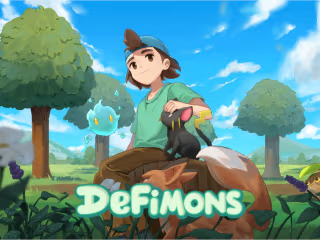In Web3 Gaming, Community is the MOAT
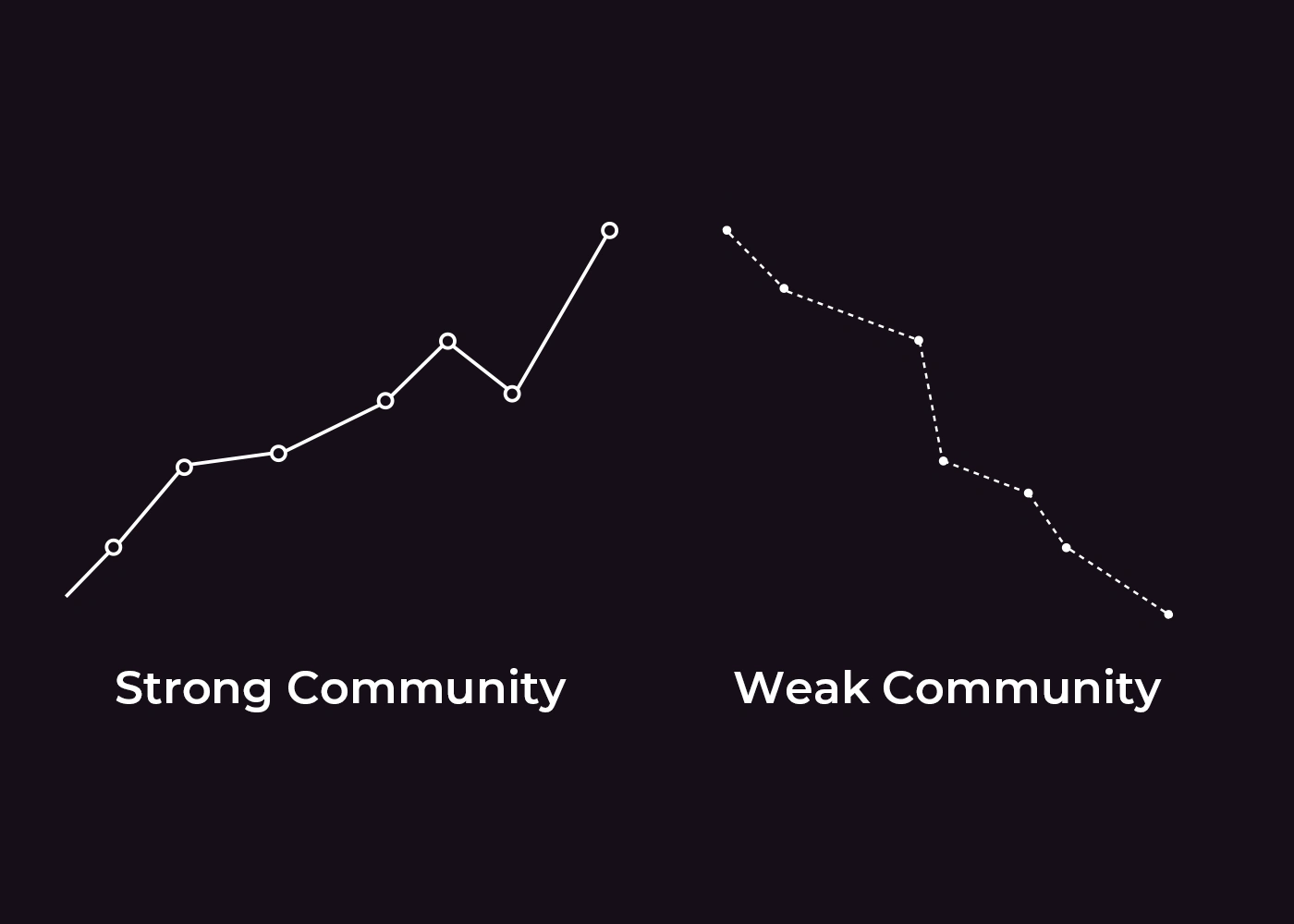
Web3: The Power of Community
While not all games require a community to thrive, it's undeniable that Web3 games heavily rely on their communities. The emphasis on community within the Web3 ecosystem brings numerous advantages, but it also presents potential downsides when projects lack the knowledge of community building, growth, and nurturing.
Having been involved in Web3 gaming for over 1.5 years and being a member of the Wolves DAO for more than a year, I have witnessed the rise and fall of many communities. Therefore, I would like to share my valuable insights and discuss how we can establish more sustainable communities.
This article expands upon a thread I previously wrote, providing a more comprehensive exploration of this topic.
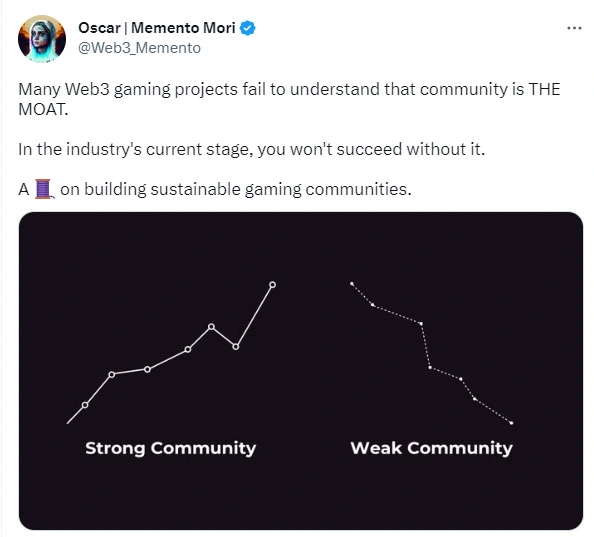
Community Creation
One crucial aspect that many projects often overlook is the investment required to build and sustain a community. It's essential for projects to carefully assess whether they have the necessary time, personnel, and resources to undertake this endeavor.
In the realm of Web3 gaming, it's common for projects to establish communities, such as Discords, well before having a playable product—sometimes even more than a year in advance. However, without an available game, maintaining long-term interest becomes exceedingly challenging.

Having an alpha, beta, or even a minigame accessible has proven to make a significant difference, not only in sustaining interest but also as an effective marketing and engagement tool. A prime example of this approach is AIArena, which chose to establish a community close to its game launch.
Regardless of whether a game is launched in proximity to its release date, projects must evaluate their available resources and consider the following questions:
Do we have enough content to generate attention on social media and attract new members?
Can we provide enough engaging content to keep our community active and involved?
Are we capable of providing regular updates on game development to maintain the interest of our community?
Can we recruit the appropriate personnel, such as moderators and community managers, to safeguard the community from malicious actors and address the aforementioned considerations?
These are just a few examples of the crucial questions that should be pondered before embarking on community creation.
Incentive Design
In the hierarchy of needs, economic security holds a higher position than entertainment or fun, making it a primary driver for incentives. When we apply this to Web3 gaming, it becomes evident that financial rewards can sometimes overshadow a person's intrinsic motivation to play a game. Consequently, when monetary gain is used as the primary attraction, individuals may join a community not out of genuine interest in the game itself, but solely for financial reasons. As a result, the likelihood of such community members truly engaging as players is significantly diminished compared to those who joined out of a genuine interest in the game.
To assess the authenticity of a community, it is important to examine metrics related to post-mint retention. These metrics include "minter to player conversion," the rate at which individuals transition from minting tokens to actively playing the game; the first-day flip rate, which measures how quickly newly minted tokens are sold or traded; post-mint chat volume, indicating the level of engagement within the community after token minting; and post-mint engagement, which measures the overall level of participation and activity following the minting process. Analyzing these metrics provides a foundation for understanding whether a community is driven by a genuine interest or incentivized by other factors.
Long-term Community Building
Given the financial nature of Web3, it can be challenging to avoid attracting individuals who are primarily motivated by monetary gain. However, implementing strategies that prioritize long-term community building can significantly reduce the presence of value extractors.
The objective of fostering a community over an extended period is to gradually cultivate and nurture the interest of its members leading up to a game launch, ultimately transforming them into active players. The essence of a community lies in its purpose, such as the creation of an enjoyable game, which serves as the cohesive element. It provides a space where members can share and indulge in discussions, fueling their passion and aspirations regarding their specific interests.
WolvesDAO
The WolvesDAO does not focus on game development; instead, it is a community founded on a shared passion for Web3 gaming. Joining this community has never been driven by financial motives but rather by the desire to create a platform where members can freely express their ideas and engage in discussions on various aspects of Web3 gaming.
By maintaining a highly selective approach to membership, the WolvesDAO has succeeded in cultivating a community that aligns with its collective vision and values. This careful selection process ensures that the community embodies the principles and ideals that the WolvesDAO aims to foster within the group.
Joining a New Community is a Process
Joining a new Discord server is an immersive experience, and first impressions play a significant role. Consequently, it is crucial for projects to ensure that navigating the community is as seamless as possible. One key aspect that new members will notice is the Discord structure, prompting community managers to empathize with them and gain a deeper understanding of the user experience. This can be achieved by considering the following questions:
How can we effectively guide new members through the community?
What are the frequently asked questions that new members may have?
Is the Discord structure overwhelming for newcomers, and if so, how can we simplify it?
When is it appropriate to ping or notify community members?
What kind of behavior do we encourage within the community?
By addressing these questions, projects can minimize friction for new members joining a Discord server. This proactive approach helps to preemptively address common inquiries and concerns, fostering a more knowledgeable and engaged community from the very beginning.
Onboarding Processes
Hosting a monthly Discord event with a high-touch onboarding process can greatly enhance the transition for both new and returning members. These onboarding events provide a simpler and more accessible method for individuals to catch up on current happenings within the Discord community, surpassing the need to extensively read prior chats and announcements. By offering this opportunity, new and returning members can quickly familiarize themselves with ongoing conversations, leading to heightened engagement.
Integrating regular onboarding events into the community strategy serves multiple purposes. It not only eases the introduction of new members but also ensures that existing members can easily reacquaint themselves with the community after a period of absence. These events become an avenue for sharing essential updates, highlighting important discussions, and guiding members on how to stay connected with ongoing conversations.
By providing a structured and inclusive onboarding experience through regular Discord events, communities can foster a sense of belonging and empower members to actively participate and engage in meaningful interactions.
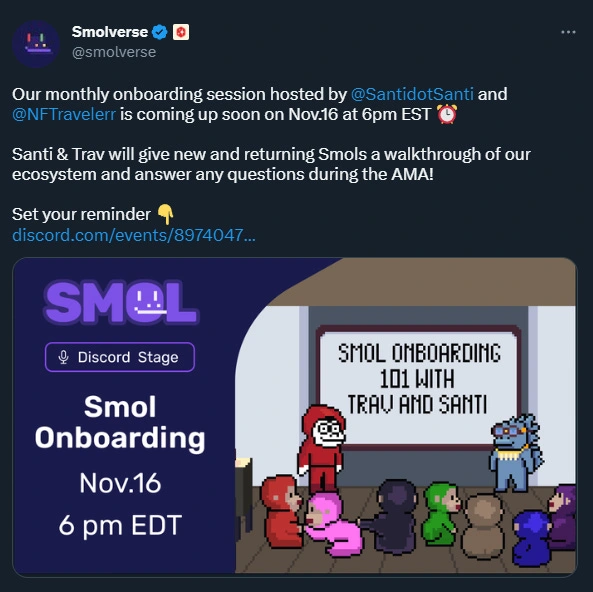
Nurture
To retain community members, projects must prioritize their nurturing efforts. It is essential to actively contribute to the community and sustain ongoing conversations to prevent the Discord from becoming inactive and unengaging.
Nurturing community members entails three key components: content, giveaways, and events.
Content
Central to maintaining member engagement and interest is the consistent provision of compelling content. Quality content not only stimulates discussions but also generates excitement. It plays a crucial role in attracting new members and retaining existing ones. Therefore, implementing a robust content strategy is vital, ensuring that it is 1) consistent, 2) evokes a desire to play the game, and 3) keeps users curious and enthusiastic.
Self-growing Content Machines
Truly outstanding projects inspire their members to embark on a similar journey. A prime example of this is the emergence of subcommunities within the larger community. These smaller groups develop their own content, contributing to the overall growth and promotion of the project. This organic generation of content not only enhances engagement but also strengthens the brand's reach and influence.
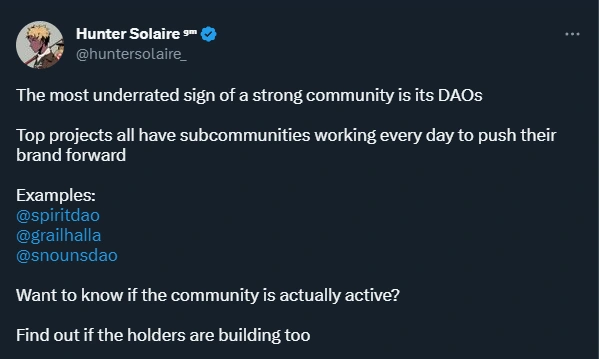
Giveaways
Giveaways have a universal appeal, especially when they come as pleasant surprises. Giving back to community members is an excellent way to show gratitude for their ongoing support and contribution to the community. However, it is important to recognize that the potential of winning something serves as a strong incentive for participation, particularly when there is a financial benefit involved.
Therefore, careful planning and design of giveaways are crucial. Currently, an organic approach to rewarding users proves to be more effective. This approach follows certain rules and processes:
Identify power users or core contributors who significantly drive the community's growth and progress.
Assign mods or community managers to oversee the giveaway process, as they are likely to have the most interaction with community members.
Publicly acknowledge and reward these individuals, without explicitly stating that specific actions (such as X and Y) led to the decision-making process.
By avoiding explicit mentions of specific actions that may be financially incentivized, this approach helps maintain a balanced and genuine community. It ensures that rewards are given based on the broader contributions and impact of community members, rather than encouraging overly specific and potentially manipulative behaviors.
Events
Events serve as powerful retention mechanisms, capable of engaging community members on a larger scale. Additionally, they offer an excellent opportunity to cross-pollinate overlapping audiences. Leveraging the availability of on-chain holder data, analytics tools can assist in identifying audiences that share common interests and holdings across projects.
For instance, the "Community Merge: Wolf Game and Infinigods" edition exemplifies this concept in action. By bringing together communities from these two projects, synergies are created, fostering collaboration and shared experiences.
Events not only contribute to member retention but also enable the exploration of shared interests and the potential for future partnerships. They serve as a catalyst for broader engagement and community growth within the Web3 ecosystem.
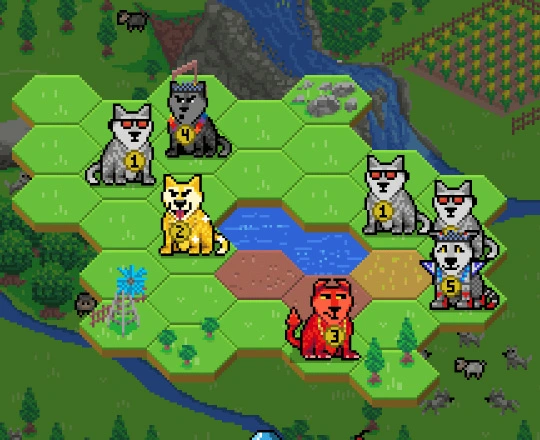
Acknowledge
Acknowledging community members who consistently contribute value is essential for creating a sense of pride and belonging. By empowering these individuals and highlighting their efforts, a positive example is set, inspiring other community members to exhibit similar desired behavior.
A noteworthy example is Azuki, which demonstrated this principle by establishing the role of "researcher in residence" to recognize their value adders. These creators, who are prominent figures in the NFT space and utilize Azuki as their profile picture (PFP), not only receive acknowledgment but also contribute to increased brand awareness for the project.
This practice of acknowledging value adders goes beyond a simple gesture; it serves as an invitation for community members to actively participate and make meaningful contributions. By celebrating these individuals, a culture of recognition and inspiration is fostered, ultimately strengthening the community's bond and propelling its growth.
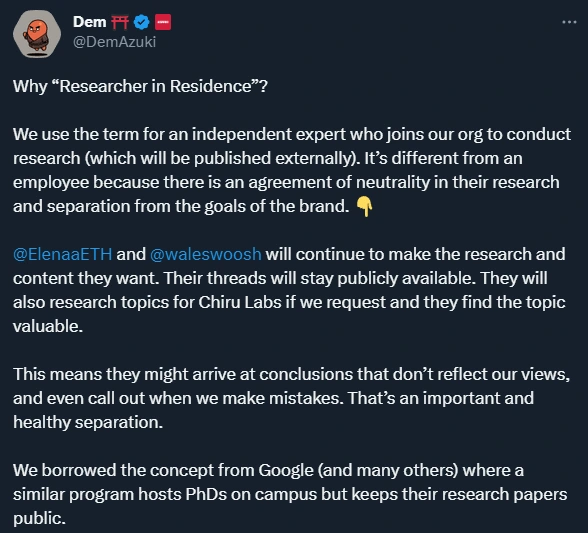
Listen
The ability to tap into the insights of a core community and leverage their feedback is often underestimated or underutilized. Many projects lack the necessary infrastructure to effectively gather and utilize community feedback.
Reducing barriers to leaving feedback is key to collecting valuable input. One solution is to establish specific Discord channels dedicated to feedback. This creates a direct avenue for community members to voice their thoughts and suggestions. Additionally, implementing democratic decision-making processes, such as voting between options 'A' or 'B', can provide valuable insights into the community's desires while fostering a sense of involvement in the creation process. Furthermore, surveys serve as a powerful tool for unearthing hidden gems, such as new product features or innovative ways to engage the community.
By actively listening to and embracing community feedback, projects can unlock invaluable insights that can drive the development of better products and enhance overall community satisfaction.
Social Capital
Consistently delivering value and providing the community with engaging content will organically inspire them to share their experiences. Enthusiastic supporters will naturally become ambassadors for the community, generating awareness and attracting new members. In essence, the community becomes self-growing, akin to the concept of "self-growing content machines."
Creator programs
Empowering creators by offering them benefits and advantages, such as exclusive access and additional resources, allows them to produce unique and compelling content. This becomes a strong incentive for content creators to cover a game or project and contribute to the growth of the community. By supporting creators, projects foster a mutually beneficial relationship, leveraging their influence and reach to amplify the community's presence and impact.
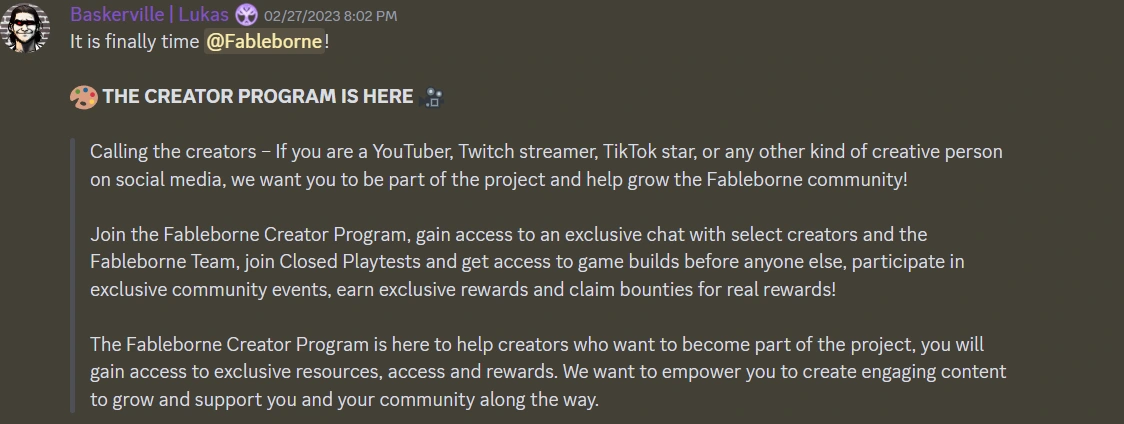
Closing
This article explores a compilation of practices aimed at cultivating sustainable growth within Web3 gaming communities. It is important to recognize that community building and expansion are continuous endeavors.
Just as in any relationship, communities require nurturing. If the flow of support and engagement ceases, members may seek alternative communities or sources of interest. A consistent and ongoing effort is vital to maintain the community's vibrancy and retain its members.
Thanks for reading Memento’s Newsletter! Subscribe for free to receive new posts and support my work.
Like this project
Posted Jun 28, 2023
In the industry's current stage, projects won't succeed without a sustainable community
Likes
0
Views
31




